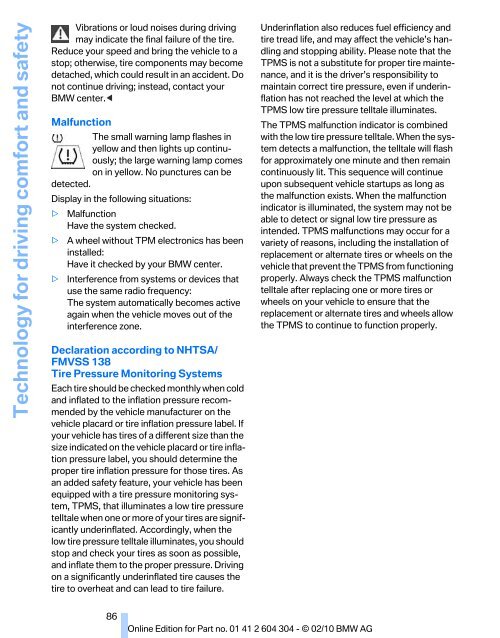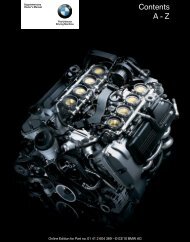2011 3 Series Owner's Manual without iDrive - Irvine BMW
2011 3 Series Owner's Manual without iDrive - Irvine BMW
2011 3 Series Owner's Manual without iDrive - Irvine BMW
You also want an ePaper? Increase the reach of your titles
YUMPU automatically turns print PDFs into web optimized ePapers that Google loves.
Technology for driving comfort and safety<br />
Vibrations or loud noises during driving<br />
may indicate the final failure of the tire.<br />
Reduce your speed and bring the vehicle to a<br />
stop; otherwise, tire components may become<br />
detached, which could result in an accident. Do<br />
not continue driving; instead, contact your<br />
<strong>BMW</strong> center.<<br />
Malfunction<br />
The small warning lamp flashes in<br />
yellow and then lights up continuously;<br />
the large warning lamp comes<br />
on in yellow. No punctures can be<br />
detected.<br />
Display in the following situations:<br />
> Malfunction<br />
Have the system checked.<br />
> A wheel <strong>without</strong> TPM electronics has been<br />
installed:<br />
Have it checked by your <strong>BMW</strong> center.<br />
> Interference from systems or devices that<br />
use the same radio frequency:<br />
The system automatically becomes active<br />
again when the vehicle moves out of the<br />
interference zone.<br />
Declaration according to NHTSA/<br />
FMVSS 138<br />
Tire Pressure Monitoring Systems<br />
Each tire should be checked monthly when cold<br />
and inflated to the inflation pressure recommended<br />
by the vehicle manufacturer on the<br />
vehicle placard or tire inflation pressure label. If<br />
your vehicle has tires of a different size than the<br />
size indicated on the vehicle placard or tire inflation<br />
pressure label, you should determine the<br />
proper tire inflation pressure for those tires. As<br />
an added safety feature, your vehicle has been<br />
equipped with a tire pressure monitoring system,<br />
TPMS, that illuminates a low tire pressure<br />
telltale when one or more of your tires are significantly<br />
underinflated. Accordingly, when the<br />
low tire pressure telltale illuminates, you should<br />
stop and check your tires as soon as possible,<br />
and inflate them to the proper pressure. Driving<br />
on a significantly underinflated tire causes the<br />
tire to overheat and can lead to tire failure.<br />
Underinflation also reduces fuel efficiency and<br />
tire tread life, and may affect the vehicle’s handling<br />
and stopping ability. Please note that the<br />
TPMS is not a substitute for proper tire maintenance,<br />
and it is the driver’s responsibility to<br />
maintain correct tire pressure, even if underinflation<br />
has not reached the level at which the<br />
TPMS low tire pressure telltale illuminates.<br />
The TPMS malfunction indicator is combined<br />
with the low tire pressure telltale. When the system<br />
detects a malfunction, the telltale will flash<br />
for approximately one minute and then remain<br />
continuously lit. This sequence will continue<br />
upon subsequent vehicle startups as long as<br />
the malfunction exists. When the malfunction<br />
indicator is illuminated, the system may not be<br />
able to detect or signal low tire pressure as<br />
intended. TPMS malfunctions may occur for a<br />
variety of reasons, including the installation of<br />
replacement or alternate tires or wheels on the<br />
vehicle that prevent the TPMS from functioning<br />
properly. Always check the TPMS malfunction<br />
telltale after replacing one or more tires or<br />
wheels on your vehicle to ensure that the<br />
replacement or alternate tires and wheels allow<br />
the TPMS to continue to function properly.<br />
86
















